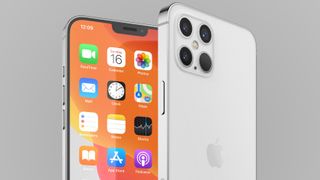the new iphone SE 2020
The iPhone SE 2020 may be the latest device to join Apple's smartphone lineup. But it's not the only phone we're expecting to see from Cupertino this year. The iPhone 12 is coming, and we could be seeing as many as four new phones this fall.
That’s when the next iPhone is expected to arrive, at least assuming there are no delays triggered by the ongoing coronavirus pandemic. And Apple is planning big changes for the devices set to replace the iPhone 11, iPhone 11 Pro and iPhone 11 Pro Max.

The iPhone 12 will likely be Apple's first device to support 5G networking. Other reports point to an all-new iPhone 12 design that gets rid of the iPhone’s distinctive notch while adding in-display Touch ID functionality. And a new type of camera could even appear on some models.
We’re still several months out from the next iPhone launch, and a lot can change — particularly the date when the phones might actually launch. But here’s what we know so far about the iPhone 12.
iPhone 12 cameras
Given that the iPhone 11 Pro and iPhone 11 Pro Max feature triple-lens rear cameras for the first time in Apple's hardware, we expect that to continue for the 2020 versions of the Pro iPhones. It’s also widely expected that the new iPhone 12 will add a new lens — a LiDAR time-of-flight sensor. Analyst Ming-Chi Kuo expects such an addition to at least two iPhone 12 models, most likely the Pro versions. Subsequent reports on iPhone 12 specs have backed that claim.
Fast Company spoke to a source that confirmed the presence of a "world-facing" 3D camera on the back of the iPhone 12, so it looks like this feature is a go, especially after 9to5Mac spotted code in iOS 14 that confirmed the existence of a time-of-flight sensor on the iPhone 12 Pro models. And, of course, the iPad Pro 2020 released earlier this year includes a LiDAR scanner, signaling Apple's plans for the iPhone 12.
A leaked iPhone 12 Pro schematic shows what a time-of-flight lens might look like on the iPhone 12 Pro's camera array, and where it fits alongside the main, telephoto and ultrawide lenses found on Apple's current iPhone Pro models iPhone 12: How many models?
Most of what we know about the new iPhone 12 thus far comes courtesy of a report from analyst Ming-Chi Kuo, who forecasts four different iPhone 12 models on tap for 2020: one at 5.4 inches, two at 6.1 inches and the largest variant measuring 6.7 inches. All four 2020 iPhones will have 5G, Kuo says.

These four phones are also expected to incorporate OLED displays, which would mark a change for Apple. Like the iPhone XR before it, the iPhone 11 features an LCD display instead of an OLED panel.
As for other specs, an investor's note from UBS has predicted that the two largest iPhone 12 models (the 6.7 and 6.1-inch versions), will have 6GB RAM, while the smaller two (the second 6.1-inch model plus the 5.4-inch model) will stick with the same 4GB RAM found in the current iPhone 11.
Incorporating 6GB RAM would make for the most memory found in an iPhone to date, which, combined with a new processor (likely the A14 Bionic) will keep Apple at the top of the smartphone performance charts. That'll especially be true if the A14 is manufactured on a smaller, more power-efficient 5-nanometer process, as some rumors have hinted.
Lately, we received confirmation that the 5.4-inch iPhone 12 model is more than a rumor. A Digitimes report on Apple's supply chain notes that two display makers are teaming up to manufacture panels for a 5.4-inch iPhone. That would confirm there's a 5.4-inch iPhone 12 in the works.
iPhone 5G: Apple's first 5G phones
A report from Nikkei says that all iPhone 12 models will ship with 5G networking capability, but the flavor of 5G may vary by the model.
According to Apple analyst Jon Prosser, all four iPhone 12 models with ship with 5G networking support. However, the 5.4-inch iPhone 12 and 6.1-inch iPhone 12 may not support mmWave technology, which offers the fastest download speeds. Instead, these more affordable devices would support only sub-6GHz 5G.
5G in this lower band offers longer range but slower data rates than mmWave technology, which can reach up to 2Gbps. The iPhone 12 Pro and iPhone 12 Pro Max will reportedly offer mmWave and sub-6GHz 5G, giving shoppers the best of both worlds. Verizon 5G is focusing, at least initially, on mmWave, which delivers the fastest speeds but typically requires line of sight.
Because Apple bought Intel’s modem business last year, it's expected that Apple will eventually stop getting its 5G modems from Qualcomm and will design its own modems in house, the same way it does for its A-series processors. That's unlikely to happen in time for the new iPhone 12, though.

إرسال تعليق
1 تعليقات
Oh
ردحذف